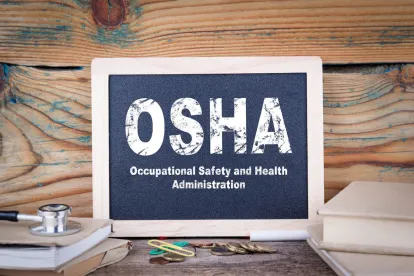Between March 9, 2022, and June 9, 2022, the US Occupational Safety and Health Administration (OSHA) will “expand its presence” in hospitals and skilled nursing facilities that treat COVID-19 patients and that were previously cited or issued Hazard Alert Letters for alleged COVID-19 violations.
IN-DEPTH
WHO IS IMPACTED?
OSHA’s stated purpose is to “target[] high-hazard healthcare facilities” to “verify and assess . . . compliance actions taken” by employers to rectify prior allegations related to COVID-19 safety violations. The initiative will focus on employers’ “readiness to address any ongoing or future COVID-19 surges.”
OSHA’s memorandum explaining the initiative lists the specific NAICS codes covered by the initiative:
-
622110 General Medical and Surgical Hospitals
-
622210 Psychiatric and Substance Abuse Hospitals
-
623110 Nursing Care Facilities (Skilled Nursing Facilities)
-
623312 Assisted Living Facilities for the Elderly
DOES THIS CREATE NEW OBLIGATIONS ON HEALTHCARE EMPLOYERS?
Notably, the initiative does not create any new obligations upon healthcare employers, nor does it reinstate, or require compliance with, the now-defunct COVID-19 Healthcare Emergency Temporary Standard (Healthcare ETS), which was adopted on June 21, 2021, and largely withdrawn on December 27, 2021. The requirements under the Healthcare ETS to record employees’ positive COVID-19 cases, and to report to OSHA all COVID-19 related hospitalizations and deaths, remain in effect.
HOW WILL OSHA ENFORCE THIS INITIATIVE?
Inspections for facilities selected as part of this initiative will fall into one of three categories:
-
Follow-up inspection of any prior inspection where a COVID-19-related citation or hazard alert letter (HAL) was issued;
-
Follow-up or monitoring inspections for randomly selected closed COVID-19 unprogrammed activity (UPA), to include COVID-19 complaints and Rapid Response Investigations (RRIs); or
-
Monitoring inspections for randomly selected, remote-only COVID-19 inspections where COVID-19-related citations were previously issued.
Each inspection will include an assessment of COVID-19 mitigation strategies, limited to the following aspects:
-
Determine whether previously cited COVID-19-related violations have been corrected or are still in the process of being corrected. For follow-up inspections of closed UPA and RRIs, determine whether COVID-19-related complaint or referral items have been corrected. Review violation worksheets or UPA complaint or referral items and any employer-provided abatement certification.
-
Determine whether the employer has implemented a COVID-19 plan that includes preparedness, response and control measures for the SARS-CoV-2 virus. If this plan is a part of another emergency preparedness plan, the review should not be expanded to the entire emergency preparedness plan (i.e., a limited review addressing issues only related to exposure to SARS-CoV-2 would be adequate).
-
Verify the existence and effectiveness of all control measures, including procedures for determining vaccination status by reviewing relevant records. Verification of vaccination protocols may be an indicator of a facility’s overall COVID-19 mitigation strategies. OSHA will refer any vaccination-related deficiencies to the Centers for Medicare and Medicaid Services (CMS).
-
Request and evaluate the establishment’s COVID-19 log and the Injury and Illness Logs (OSHA 300 Log, OSHA 300A Summary and any applicable OSHA 301 Incident Reports) for calendar years 2020, 2021 and 2022, if available, to identify work-related cases of COVID-19.
-
Review the facility’s procedures for conducting hazard assessments and protocols for personal protective equipment (PPE) use.
-
Conduct a limited records review of the employer’s respiratory protection program. The records reviewed may be limited to the written respiratory protection program and fit tests, medical evaluations, and training records for the interviewed employees.
-
Perform a limited, focused walkaround of areas designated for COVID-19 patient treatment or handling (common areas, walkways, and vacant treatment areas where patients have been or will be treated), including performing employee interviews to determine compliance.
The “walkaround” portion of the inspection will be less extensive than a typical inspection, limited in scope and focused on the areas of potential non-compliance listed below. The scope of an inspection may be expanded, however, where plain-view hazards are identified during the walkaround, or where information obtained from workers or worker representative(s) indicate deficiencies in compliance:
-
Determine compliance under the Respiratory Protection Standard (29 CFR 1910.134), especially in areas involving close-contact work with suspected or confirmed positive COVID-19 patients, to include fit testing, medical evaluations, training and proper use of respirators; and conduct employee interviews.
-
Review documentation of any procedures or efforts made by the employer to obtain and provide appropriate and adequate supplies of PPE.
-
Determine whether the employer has implemented procedures for screening workers and/or any measures to facilitate physical distancing (e.g., barriers or administrative measures to encourage six-foot distancing).
-
Determine whether the employer ensures the use of face coverings or facemasks by employees, and by visitors in accordance with current public health guidance from the Centers for Disease Control and Prevention (CDC) available here https://www.cdc.gov/coronavirus/2019-ncov/index.html.
WHAT ABOUT STATES WITH STATE OSHA PLANS?
The 22 states with approved State OSHA Plans are not required to implement this initiative. Federal OSHA is providing guidance to State OSHA Plans for informational purposes and consideration. As of the date of this article’s publication, no State OSHA Plans had announced an intent to adopt this initiative. Employers are encouraged to contact their McDermott Will & Emery lawyers to receive the latest information on this initiative’s impact in states with their own State OSHA Plans.
HOW CAN HEALTHCARE EMPLOYERS COMPLY WITH THIS INITIATIVE?
While healthcare employers no longer need to follow the rigorous steps laid out in the Healthcare ETS, OSHA has stated that it will accept continued compliance with the Healthcare ETS as one method of satisfying employers’ existing obligations under other OSHA regulations.
OSHA may enforce COVID-19 safety requirements under several existing requirements:
-
29 CFR Part § 1904, Recording and Reporting Occupational Injuries and Illness.
-
29 CFR § 1910.132, General Requirements-Personal Protective Equipment.
-
29 CFR § 1910.134, Respiratory Protection.
-
29 CFR § 1910.1020, Access to Employee Exposure and Medical Records.
-
29 CFR § 1910.502(q)(2)(ii) and (q)(3)(ii)-(iv), Healthcare ETS COVID-19 log and Availability of records.
-
29 CFR § 1910.502(r), Healthcare ETS Reporting COVID-19 fatalities and hospitalizations to OSHA.
-
Section 5(a)(1), General Duty Clause of the OSH Act.
Healthcare facilities may continue to be subject to the CMS vaccine mandate. Employers should remain cognizant of state and local vaccine mandates and other requirements that may impact COVID safety procedures. Compliance with these measures may also be considered when OSHA assesses employers’ good-faith efforts to maintain safe and healthy workplaces.
Employers should work with outside counsel to conduct a focused, high-level assessment of any COVID safety compliance measures undertaken by healthcare facilities that may fall within the purview of OSHA’s new initiative. Although general COVID-19 safety standards are becoming more relaxed, this initiative is a clear signal from OSHA that healthcare employers must remain just as cautious as ever.





 />i
/>i

